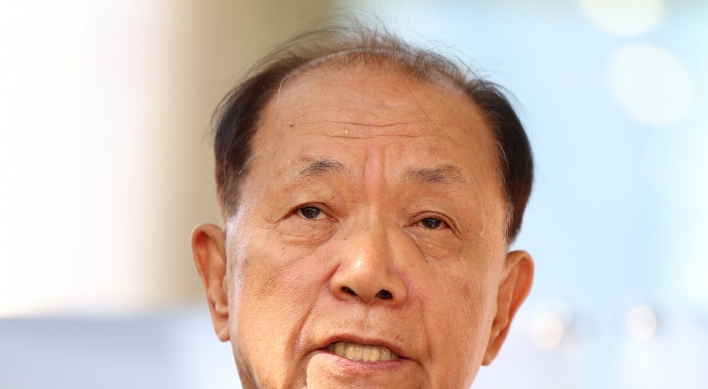No. 1 newspaper solidifies position, embraces changes
The Korea Herald has served as a leading English newspaper in South Korea over the past six decades. The 59th anniversary this year, which falls on Wednesday, carries a special meaning, as the paper is readying itself for a fresh move forward including a set of reforms in design and content ahead of the 60th milestone next year.
It was Aug. 15, 1953 that the inaugural edition of The Korea Herald, then called The Korean Republic, was published with the special mission of making the country better understood by the outside world after the 1950-53 Korean War thrust Korea into the international spotlight.
Shortly after the end of the Korean War, The Korea Herald started as a humble four-page tabloid, which was then produced by a staff of three reporters, a managing editor and one photographer. The type-setting was done on a single Linotype machine ― the first to be brought into the country.
A major change took place in July 1961 when the paper switched format to broadsheet. Four years later, the name was changed to The Korea Herald.
The original office was located in a dilapidated two-story building in Mugyo-dong, near where the Lotte Hotel stands today. In 1978, the paper and its sister paper, the Korean-language Naeway Economic Daily, which has since been renamed the Herald Business, moved to their own modern building in Hoehyon-dong. In July 2005, the paper changed its address again to its current building in Jung-dong near Gwanghwamun ― the very heart of the metropolitan city.
To better meet the demands of readers, the paper expanded the number of pages, from four to eight pages in 1975 and to 12 pages in 1986. Currently, the paper publishes 20 pages on weekdays.
The design and content of The Korea Herald have been upgraded several times in the past decade, and the latest version comes with another set of major reforms ranging from look and feel to details in content throughout the paper.
The dynamic changes for the readers both at home and abroad are not limited to the offline version of the paper. The Korea Herald’s website, launched in 1995, is already at the forefront of the country’s digital media, maintaining the No. 1 slot in the English newspaper category in terms of online readership.
The paper has also launched a host of mobile applications targeting a new generation of readers who prefer iPhones, iPads and Android-enabled smartphones and tablets in getting the latest news on the go.
The Korea Herald, a unit of Herald Corp., is embracing changes to better utilize a new wave of upheavals in the print and digital media industries. What’s not changed, though, is the paper’s commitment to upholding the ideals of a free, democratic and one day unified Korea while acting as a bridge between Korea and the world, as pledged in the inaugural edition 59 years ago.
By Yang Sung-jin (insight@heraldcorp.com)
English dailies in Korea contribute to nation building, development
The history of English dailies in Korea dates back to late 19th century, when the first daily, the Independent, was launched by Seo Jae-pil in 1896.
The paper, also called Tongnip Shinmun, published both Korean and English editions every other day, featuring editorials, local items, government news and advertisements.
Several other English dailies, weeklies and monthlies followed shortly after, including the Korea Daily News, the Seoul Press and Morning Calm.
However, English publications did not continue for long under the Japanese colonial rule.
After Korea’s liberation from Japan in 1945, Korea saw explosive nation-rebuilding in every sector including the media. More than 20 English-language dailies were established shortly after liberation, including the Seoul Times and the Korea Union Times ― all of which ceased publication before or with the outbreak of the Korean War (1950-1953).
The Korea Herald and the Korea Times, established in 1953 and 1950, respectively, are the only two major English-language dailies in Korea that survived that era through today.
The Korean Peninsula, divided after the Korean War, was geopolitically significant for major international powers to expand or maintain their influences in Northeast Asia.
South Korea’s politics, diplomacy, administration and economy were all under the direct influence of the U.S. Under such circumstances, the impact of English media was profound as international communication tools were limited at that time.
In early 1953, the U.S.-educated then-President Syngman Rhee ordered then-Public Information Office director Karl Hong-kee to establish a new, government-funded English-language newspaper company, the Korean Information Service. Within months, the English daily was founded under the name of The Korean Republic ― later to become The Korea Herald ― on Aug. 15, 1953.
The front-page story of the first issue of The Korean Republic covered Rhee’s national address to mark the Aug. 15 Liberation Day, in which he called for an early reunification of North and South Korea despite the armistice agreement of the Korean War in July 1953.
On the second-page editorial, the paper proclaimed its aspiration to become “a dependable source of world news for our readers in Korea and of Korean news for the foreigners in our midst and abroad.”
The Korea Herald was privatized in 1978 as the Korea International Trade Association took over the ownership. The ownership was transferred to Daenong Group in 1989 and to Shin Dong Bang Corp. in 1997. Then in 2002, high-profile financier Jungwook Hong ― currently chairman and largest shareholder of Herald Corp. ― became the new owner of The Korea Herald-Naeway Economic Daily.
By Kim Yoon-mi (yoonmi@heraldcorp.com)
-
Articles by Korea Herald







![[KH Explains] No more 'Michael' at Kakao Games](http://res.heraldm.com/phpwas/restmb_idxmake.php?idx=644&simg=/content/image/2024/04/28/20240428050183_0.jpg&u=20240428180321)











![[Herald Interview] Mistakes turn into blessings in street performance, director says](http://res.heraldm.com/phpwas/restmb_idxmake.php?idx=652&simg=/content/image/2024/04/28/20240428050150_0.jpg&u=20240428174656)
